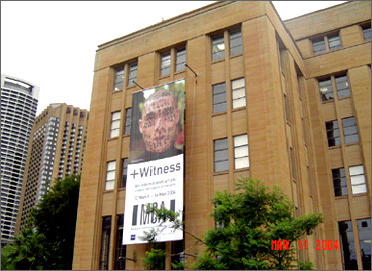By Thom Collins
Witness, Published by Museum of Contemporary Art, Sydney, Australia

View of Museum of Contemporary Art, Sydney, Australia
Zhang Huan
Zhang Huan graduated from Beijing’s Central Academy of Fine Arts in 1993 with an advanced degree in traditional painting techniques. Chafing at the expressive limitations imposed upon him by an authoritarian government and rigid society, he and a group of like-minded friends founded an alternative artists’ collective principally dedicated to time-based arts in the early 1990s. The East Village group, as they came to be known, lived and worked on the outskirts of the capital city. Together they pioneered a performance practice involving heavily symbolic acts of endurance and collective action.
Working in the context, Zhang Huan devised a first solo piece entitled Angel (1993). In this performance, presented in conjunction with the opening of a painting exhibition at the National Art Gallery in Beijing, he spread a white sheet on the ground in front of the exhibition venue, stripped almost naked, and emptied over his body a jar containing bloody red liquid and the parts of a dismembered doll. He then reassembled the baby and carried it into the gallery, where it was displayed as his ’painting’. This work, a startling and visceral commentary on the Chinese government mandate of abortions for women conceiving more than the legal limit of one child, led to a quick closure of the exhibition and serious censure of the artist.
Angel is characteristic of the performances for which Zhang Huan has subsequently become known. As in this work, he typically appears undressed in non-theatrical settings, sometimes accompanied by local volunteer participants. He proceeds through a series of loosely structured activities and poses that describe open-ended narratives with autobiographical and social-critical implications. Among the topics he has addressed, in some 40 performances, are the power of unified action to challenge oppressive political regimes; the status and plight of the expatriate in the new global culture; the persistence of structures of faith in communities undermined by violent conflict; and the place of censorship in contemporary democracy.
Less well known are his non-performance-based works. Three - the photographic series Foam (1998) and Family Tree (2000), and the enormous bronze sculpture Peace (2001) - taken together, describe a slightly different set of preoccupations and a more focused line of investigation. In them, the artist presents his body again as a legible symbol, but now transformed in ways that recall his family history and speak to his experience of family as the most profound and formative of his life - a source of general inspiration and explicit subject of much of his performance work.
This idea is made iconic in Foam. Zhang Huan’s face is isolated in the ten pictures in the series. In each, he appears covered in white suds like sea foam with a snapshot of members of his wife’s family or his own bursting out of his mouth as if it were a sound. Here, Zhang Huan appears new-born - covered with a substance that might refer to both the human birth process and the birth of a mythological character in the waves - but also in the throes of an irresistible utterance. This speech act, his pictures suggest, while an expression of self, has also inevitably been shaped by his own lineage and that of his life partner and mother of his children. His ancestors speak through him.
Family Tree broadens this vein of exploration to describe the domestic scene as a site of initiation into ideology. The photographic series comprises nine sequential images made at regular interval from dawn until dusk on one day. Again, they all feature the face of Zhang Huan, the physical trace of his lineage. Throughout this process, the artist dictated to three calligraphers a stream of familiar names, personal stories, learned tales, and random thoughts. Each was transcribed in ink onto the artist’s face until, at the end of the day, he was completely covered in a thick layer of black pigment. Here, the contents and processes of an individual consciousness, learned from forebears and / or organized according to systems of belief conditioned by experience with them, become a mask or second skin. They are inseparable from that which the rest of the world takes to be a unique identity and original producing consciousness.
The large bell apparatus of Peace is, like both Foam and Family Tree , a symbolic self-portrait. Inspired by the small, hand-held bell used in traditional Tibetan Buddhist ritual practices, it represents wisdom - the female face of the life force - and it is rung to clear malign spirits and to consecrate a space at the beginning of ritual activity. Zhang Huan’s bell is elegantly inscribed with the names of eight generations of his ancestors. It is rung with a large and detailed cast of the artist’s body, an object that in its specific anatomy and general phallic form is the male counterpart to the bell, and it represents the compassion that is the necessary counterpart of wisdom. The act of ringing the bell - slamming the figure of the artist into the record of his ancestry to produce a beautiful and powerful sound - suggests that artistic struggle with the circumstances of and inheritance from family is both necessarily violent and richly generative. |